Water whips past, flicking up foam. But the ‘boat’ is stationary – tethered to the sea floor, it is in fact a 1.5MW tidal energy generator.
Developed by Spanish firm Magallanes Renovables, the ATIR platform has two turbines submerged in the fast-flowing waters of the Fall of Warness, south of the island of Eday in the Orkneys. The device is a piece of cutting-edge renewable-energy technology in a seemingly remote environment, but it is far from the only one here. Just 100m away there is another bright yellow tidal energy generator, the O2 by Orbital Marine Power. Elsewhere, there are wave-energy converters and wind turbines. Onshore there are more wind turbines, electrolysers for the production of ‘green’ hydrogen, and infrastructure to put the gas to good use.
At the heart of it all is the European Marine Energy Centre (Emec), which has been diligently transforming this northerly archipelago into a global leader in marine renewable power since its formation in 2003. Now, Orkney offers a model for the future. The work going on here could have huge consequences for renewable energy around the UK – and the world.
Orcadian rhythms
Dropping out of the clouds above Orkney the sea melts into view like a smooth blue tabletop, but the appearance is deceiving. The straits and natural harbours surrounding the 70 islands are home to some of the fastest flowing and tumultuous waters in the British Isles.
Billia Croo, home to Emec’s grid-connected wave-energy test site, has an average wave height of 2-4m and a record height of 20m. The Fall of Warness, where Magallanes and Orbital are testing their devices, has a peak tidal flow of 4m/s. During a peak tide, half a billion tonnes of water flow through the site every hour.
Today, as we steam across the water from the mainland – as the largest island is known – to the test site, there is little sign of such raw elemental energy. Our craft easily skims through the smooth water. As we enter the tidal current, however, the boat suddenly starts to pitch and roll – gently, but noticeably.
Created by adapting proven technology from the wind energy and the marine industry, the ATIR platform is aimed at maximising the amount of energy that can be harvested from the vast and predictable tides, with the minimum of fuss.
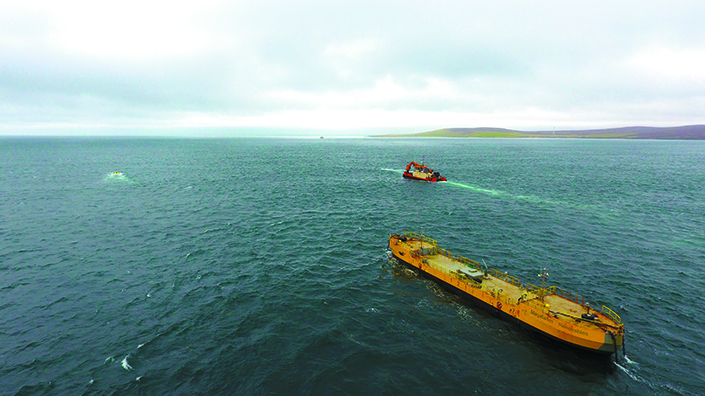
The ATIR platform generated 100MW in three months in the fast-flowing waters of the Fall of Warness
Started as a spin-out R&D project in 2009, Magallanes Renovables brought its full-scale 42m prototype to the Fall of Warness in 2019, and in 2020 it generated 100MW in three months. As we visit the platform in September, the firm is planning to reconnect to the grid and start generating for the rest of the year.
“The first megawatt we produced was very exciting,” says control engineer Javier Grande as we approach the machine. “When you’re in the platform and you start to generate power, the platform starts to move a little bit, like surfing in the tidal current, and it’s a strange feeling... but you see that we are generating power, sending power to the grid.”
After hopping from the boat onto the platform – trying to ignore the coursing water below – we look around the deck. On top, there is not a lot to see. Communication masts with cameras and positioning instruments are the tallest objects, while the end of the 11kV electricity cable shows that this is not merely an experiment.
At one end is a hole, through which a current meter has been lowered. The team uses the speed of the current and the diameter of the turbines to work out the expected power output. They reportedly achieve performance of 50% efficiency, with a theoretical maximum of 59%.
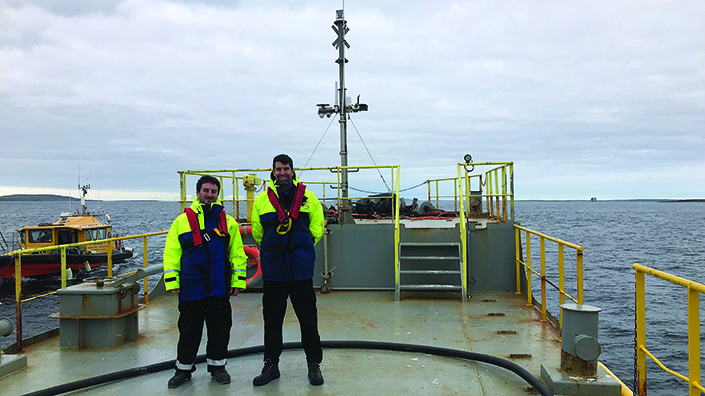
Pablo Carpintero and Javier Grande from Magallanes Renovables on the ATIR platform
The secrets of the platform are hidden below, through a hatch and down a ladder. One deck runs the whole length, housing the vast array of electrical equipment – switches, transformers, converters, relays and the control system are all here.
The real magic happens 15m below the surface, down a rudder-shaped mast that helps maintain the platform’s position in the water. At the base, the two counter-rotating turbines are extended out fore and aft, about 20m away from each other.
The hollow mast gives direct access to the powertrain while the machine is in place. The turbines can turn in either direction and the slow shaft turns at a maximum of 16rpm, which is boosted 100 times by the gearbox.
Magallanes engineers can control the machine from shore, but the control system is designed to handle everything itself. When in use, it changes parameters such as turbine blade angle – changing the speed of rotation – and distribution of water ballast – keeping the platform level.
Working in such a new field is far from simple. “It’s very frustrating, because with each three steps you take, you have to take two steps behind,” says Grande. The first mooring lines caused too much vibration in the platform, for example, while the strong tide broke the platform’s original cable. “All of the time we are failing, and then developing new solutions.”
Now, the team is testing and analysing the control system, and aiming to once again prove the device’s grid-ready capabilities. They are focused on making the technology competitive and cost-effective to encourage government investment. Turbine diameter can be increased to harvest more energy from slower waters, for example, while predictive maintenance will minimise costly boat trips to tidal sites.
New wave
After returning to Kirkwall on the mainland, it’s just a short hop across the island’s isthmus to Scapa Flow in the south. Home to Emec’s scale wave test site, it is a vast natural harbour sheltered by five islands.
Heading out to Mocean Energy’s wave-energy converter, the difference in the water is immediately clear. Whipped into peaks and with the sun beaming down, it looks more like sculpted mineral than anything else. The firm waves are cogs in the inter-island marine energy system.
After a bracing, bumpy ride out, we reach the Blue X device. As with the tidal machines, the 20m-long half-scale prototype is painted bright yellow to stand out in the waves, and the not-infrequent bouts of grey, foggy weather.
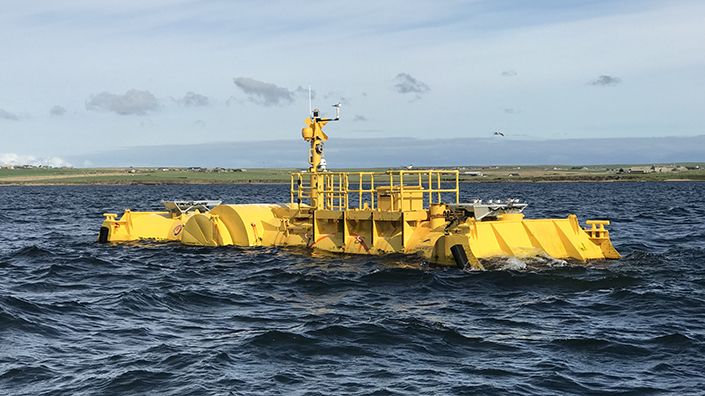
The Blue X device by Mocean Energy
Built entirely in Scotland, the 38-tonne machine has two main parts, connected by a giant hinge. The front arm faces into the waves with a shovel-like part plunged 4m beneath the surface, forcing as much of the water’s energy as possible through the device. It houses a small deck, with a comms mast and access hatch, and one of two solar-panel installations. The rear arm is much smaller, with another scoop-like extension beneath the water.
As waves travel along the length of the machine, its buoyancy forces it to flex around the hinge – once at the peak and once at the trough, rotating ±20º but accommodating more movement. This reciprocal motion goes through a gearbox, where it is spun up to a higher speed and fed into the AC electrical generator.
The Blue X, forerunner of a planned utility-scale machine known as Blue Horizon, was created using generative design to find its optimal shape. Its size was aimed at rougher conditions than Scapa Flow and the site has only provided appropriate waves very sporadically, but that was enough for the team to generate power and carry out testing.
Commercial devices will be scaled to fit the waves in their locations, says Mocean founder and technical director Chris Retzler. Off-grid and remote applications will be most promising at first, the company believes, with Blue devices providing power for coastal communities or businesses, environmental monitoring, or even oil and gas platforms as fossil-fuel companies seek to minimise emissions.

Chris Reztler on the deck of the Blue X
Next year, for example, Mocean will take part in Renewables for Subsea Power, funded by the Net Zero Technology Centre in Aberdeen and several oil and gas companies. The project will see Blue X deployed off the east coast of Orkney, with an ‘umbilical’ down to a subsea skid on the seabed, which will power oil and gas control modules and an autonomous underwater vehicle. But Retzler and Mocean co-founder Cameron McNatt believe the future could also hold large utility-scale deployment, with dozens of megawatt-scale devices joined together.
“When we get to the utility scale, we see it actually combined with offshore wind,” says McNatt, speaking from his office. “Offshore wind is going further offshore, and you’re getting to floating offshore wind. They are really good environments for wave as well.”
Combined wind-and-wave farms would maximise the energy that can be harvested from an area of ocean, lowering the overall cost.
“Another benefit is that waves are generated by wind, but there’s essentially a phase lag in between when the wind energy passes through a given location, and the wave energy,” says McNatt. “You’ll get a storm that comes across the ocean, and you get that wave energy or wind energy at the shore... but you’ll get a more substantial swell days later, and that’s quite useful from a grid perspective as well, because then you’re providing a more consistent supply of energy.”
The firm is also keen to integrate solar panels onto devices, and Blue X has two sets of panels when we visit. Unfortunately, they are covered by seabirds – and, underneath the birds, a slight problem. “We talk about bird poop a lot more now than I had expected,” says McNatt. “It’s a real challenge.”
Talking to Retzler back on Scapa pier, the razorbills and guillemots look nothing like potential threats to future renewable energy infrastructure. Puffed out like miniature inflatables, they pedal gently over the harbour’s shallow water, gracefully dipping below every now and then in search of lunch.
The question of wave versus tidal has come up. “There is so much area in which wave energy can be harvested, so it’s not restricted to the very small set of suitable locations that tidal energy is,” says Retzler. “The ocean surface is vast.”
When it comes to government support, however, tidal seems to be more in favour. “Just as tidal energy has, wave will need revenue support, the equivalent of Contract for Difference-type funding, and we need support for early projects to get them to commercial scale,” says Retzler.
Peaks and troughs
Later, I travel with Emec managing director Neil Kermode from the centre’s headquarters at the Heriot-Watt University campus in Stromness, to the grid-connected wave-energy test site at Billia Croo – or Billia Spew, as some seafaring locals apparently call it.
“The next thing out there,” says Kermode, gesturing to the horizon, “is Canada.” That distance, plus strong winds blowing from the west, brings huge waves.
Such a suitable ‘wave regime’ made Billia Croo and Orkney obvious choices when the Highlands and Islands Enterprise – following on from the government’s Science and Technology Committee – set out to find a location for a marine energy test centre in 2001. Emec was established two years later.
Since then, the centre has tested 32 machines from 21 developers, based in 11 countries. Over time, they have spent £36m on infrastructure, but provided a ‘gross value add’ of about £306m to the UK economy.
As the world’s only grid-connected test laboratory for wave and tidal energy machines, Emec is aimed at ensuring that devices are safe, dependable, environmentally friendly and worth investing in. It does this by providing reports to customers on how well their devices perform.
Efficiency has increased over the years of testing, Kermode says, particularly on the tidal side. This is partially thanks to companies building bigger devices – the first machines offered about 0.25MW, while the Orbital O2 offers 2MW. The turbines are becoming more sophisticated, with variable-pitch blades maximising the amount of energy that can be extracted.
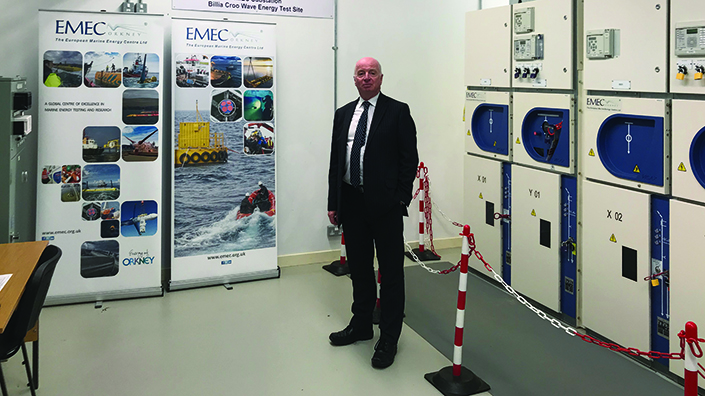
Neil Kermode from Emec at the wave test site substation in Billia Croo
Reliability has also improved, thanks in large part to a shift towards surface-mounted machines. Technicians can easily catch a boat to a turbine, jump on, and do the maintenance needed to get it online. With seafloor-mounted turbines, such straightforward maintenance was impossible.
“You need to have these machines do what they say on the tin, not just once but in an enduring way,” says Kermode. “That’s another big piece of this, not strictly the mathematical performance, but actually the endurance.”
A sea of opportunity
Even before marine renewables reach their full potential, the islands already have a unique problem – they generate too much wind energy for the grid to handle. This constrained the amount of new capacity that could be added, hindering installation of new marine devices.
Emec’s solution was two-fold – the first was getting involved in energy system projects such as ReFlex, which deployed hundreds of domestic batteries and battery-electric vehicles to create a ‘virtual powerplant’.
The second was hydrogen, offering a way to store excess energy for later use. The centre’s electrolyser uses renewable energy to turn water into oxygen and hydrogen, which is then used for a variety of things – a large fuel cell on Kirkwall Marina powers electricals on ferries while they are in port, for example. Hydrogen is also used in boilers on Eday and Shapinsay. There is a refuelling point for hydrogen cars. The Hyseas III project aims to develop the world’s first seagoing hydrogen-powered passenger ferry, and Emec is even working with ZeroAvia and other partners to explore island-hopping hydrogen-powered flights.
Hydrogen effectively closes the loop, bringing renewable energy, the grid, transport and heating together into a joined-up, sustainable system. It is the kind of approach that could point a way forward for the UK.
Orkney is “like a version in miniature,” says Emec R&D engineer James Ferguson, speaking alongside the Kirkwall fuel cell – “a place with excellent renewable resource and a constrained grid, which might be a signpost to what the UK can expect to see in a couple of decades’ time.”
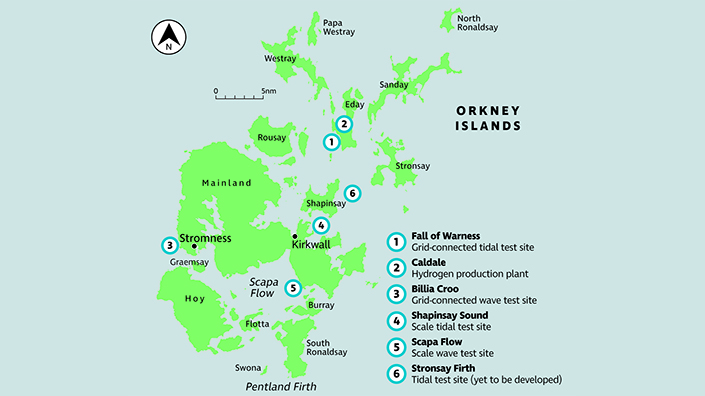
The location of the Emec test sites around Orkney
With such expertise, and results to back it up, Emec is perfectly suited to lead a UK-wide push for investment in marine renewables. There is some optimism, following more acknowledgement of tidal-stream energy in the government’s recent support mechanism than there has been for the past four or five years.
“We just need to make sure that the UK makes the most of the resources that we know are out there,” says Neil Kermode. “Sometimes that’s a bit of a challenge to explain to government – that they need to invest today for there to be something to do tomorrow.”
Bold policies and acceptance of innovative technologies could cut emissions, increase exports, and provide thousands of green jobs, and Emec shows what a future-thinking engineering-led project can give to local communities. Speaking as we return from the tidal site, Stromness-born boat skipper Sandy Galbraith says: “It’s been very, very good for Orkney, and Stromness in particular. A lot of other towns in Scotland have a real problem attracting young folk, or being able to provide jobs for them. We’re really lucky in Orkney that that’s not the case, and renewables are a big factor.”
That success could be replicated elsewhere, but Kermode warns that the UK could be left behind without sufficient investment. Canada has already attracted at least two developers from the UK, he says, and Emec is working with groups in France, Oregon, New York, Japan and Chile. “There are 5,000 communities in Chile off the grid,” he says. “That’s 5,000 groups of people running on diesel generators at the moment. We can find a way to – if not turn them off – turn them right down. You can’t say ‘This will solve this problem’, but if you can take 90% out, the last 10% is a lot easier to tackle.”
It is clearer than ever that there is not one silver bullet for climate change. But, thanks to some dedicated work off the north coast of Scotland, we might soon have an array of yellow devices ready to make a big contribution.
This article originally appeared in Professional Engineering, Issue 6, 2021. Make sure to visit the Professional Engineering website throughout the week (29 November – 3 December) for more Energy Islands stories and interviews.
Want the best engineering stories delivered straight to your inbox? The Professional Engineering newsletter gives you vital updates on the most cutting-edge engineering and exciting new job opportunities. To sign up, click here.
Content published by Professional Engineering does not necessarily represent the views of the Institution of Mechanical Engineers.